
This past week was the fall equinox which marks the beginning of the fall season. With the cooler weather in recent days, it has really started to feel like the time of changing leaves and brilliant autumn colors. While most of us are thinking of tree color this time of year, there are some spectacular late blooming plants that provide a characteristic fall flare of color late in the growing season.
Goldenrods and asters are two taxa of late blooming species that are hard to miss this time of year. Beyond the backyard beauty they provide, these plants are also important support for pollinators late in the year.
As the warmer part of the year winds down, pollinating insects begin to prep for the winter. Some, like the monarch butterfly, migrate to warmer climates, but others, such as bumble bees, carefully store away provisions this time of year for use in spring. It’s their last chance to stock up before a long winter’s rest, and many bumblebee species overwinter as a solitary queen. In spring, floral resources can be scarce, so it is often critical for queens to have adequate stores of food so they have resources to help build their new colony for the year.
Whether it’s a monarch butterfly that needs energy for a several thousand mile migration or an overwintering bee, these late-season floral resources are incredibly important and can often be scarce in many home gardens.
The addition of both goldenrod and aster species can help complete the bloom season in your garden space. However, one common complaint about both of these genera is their aggressive growth habit.
This can be a positive attribute if you have space to fill, but for someone like me, with an already-packed garden, I worry that aggressive asters may crowd out other species that I’ve planted. It’s a bit of a double-edged sword because I do really like plants that compete with weeds, but I don’t want their growth to engulf neighboring plants.
So, it certainly takes the right planting location to incorporate some of these species, but using their aggressive habit to your advantage can actually be a help. For example, we have a really nice section of garden that is filled with aromatic aster (Symphyotrichum oblongifolium). I just love this plant because it blooms so late in the season and continues straight into frost. Right now, it has hardly formed a flower, but in the next few weeks our patch will explode with tiny aster flowers, and it will be the center of pollinator activity in our front yard.
We intentionally place this aster in a corner of garden that is contained on one side by a sidewalk and another side is a walking path. A third side is actually a small rock-lined drainageway. By confining this species with hardscaping on three sides, there is only one side of the planting left to plant competition. On this end, we’ve added palm sedge (Carex muckingumensis), which seems to be doing an excellent job of lining the edge of our drainage way while competing with the asters. With some minimal hand pruning, the advancing edge of aster can be easily subdued to favor the sedge, which creates a nice textural change, with it coarse foliage, at the edge of the bed, plus some nice yellow fall color to contrast the aster blooms.
Not all of these species will mount an attack on their neighbors, so another strategy with both asters and goldenrods is to seek out some of the less aggressive ones. With the goldenrods, I have really enjoyed both showy goldenrod (Solidago speciosa) and stiff goldenrod (Oligoneuron rigida). Both are easy to grow and provide excellent late-season blooms. Among the asters, I really like smooth blue aster (Symphyotrichum leave) for its spectacular flower display and more laid-back, clump-forming growth habit.